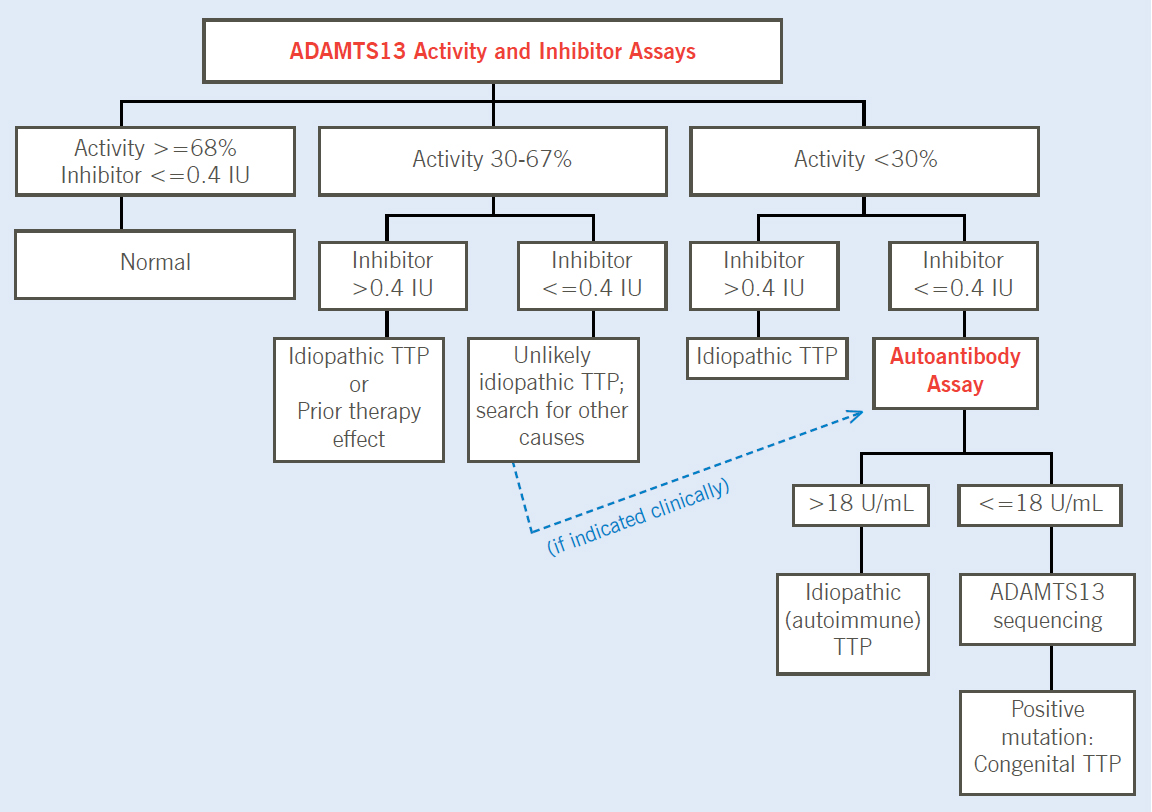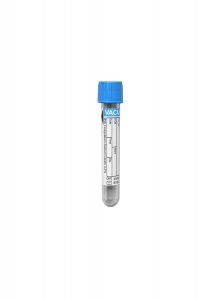Test Name
CPT Codes
ADAMTS13 Activity Assay
85397
85390
ADAMTS13 Inhibitor Assay
85335
85390
ADAMTS13 Antibody Test
83520
85390
Methodology
Enzyme Immunoassay (EIA)
Turnaround Time
2 – 4 days
Specimen Requirements
Volume:
2 mL
Specimen Type:
Plasma
Collection Container:
Light Blue VACUETTE® Sodium Citrate Coagulation Tube
Transport Temperature:
Frozen
Specimen Collection & Handling
The preferred blood specimen is collected by routine venipuncture in 1.8 mL light blue top tube containing a 9:1 ratio of blood to 3.2% sodium citrate anticoagulant.
Citrated plasma with an appropriate ratio of anticoagulant (3.2% sodium citrate) is acceptable.
The presence of heparin, fondaparinux, dabigatran or another direct thrombin inhibitor in the specimen may interfere with test results.
Stability
Ambient:
7 days
Reference Range
See Interpretation
Additional Information
Background Information
Many studies on the pathophysiology of thrombotic thrombocytopenic purpura (TTP), a rare life-threatening disease characterized by microangiopathic hemolytic anemia, thrombocytopenia and multi-organ failure, have been published over the last two decades. The most significant finding was the identification of ADAMTS13 (a disintegrin and metalloproteinase with thrombospondin type 1 motif, member 13) that is involved in the regulation of the size of von Willebrand factor (VWF), a plasma protein responsible for regulating the interaction of platelets with von Willebrand factor (VWF) and physiologic proteolytic cleavage of ultra-large (UL) VWF multimers at the Tyr(1605)-Met(1606) bond in the A2 domain of VWF.
Reduced or absent ADAMTS13 activity can retain UL VWF that can trigger intravascular platelet aggregation and microthrombi causing clinical symptoms or signs of thrombotic thrombocytopenic purpura (TTP). Measurement of ADAMTS13 activity, its inhibitor, and antibody (in some cases) is crucial in the diagnosis of TTP, potentially fatal thrombotic microangiopathy (TMA) syndrome and further differentiation of congenital (Upshaw-Schulman syndrome) versus acquired (e.g. autoimmune-related disorder) etiology.
TTP has an estimated incidence of four to six cases per million, and affects women more often, particularly pregnantor postpartum women (estimated incidence of one per 25,000 pregnancies) and African-Americans. TTP is primarily diagnosed clinically, and its correct diagnosis is often very difficult. TTP is characterized by microangiopathic hemolytic anemia including numerous schistocytes in the peripheral blood smear, thrombocytopenia, neurologic symptoms, fever, renal dysfunction, variable organ damage and ischemia, and deficient ADAMTS13 activity, usually less than 30%. Approximately two-thirds of patients with a clinical diagnosis of idiopathic TTP will have less than 10% ADAMTS13 activity.
Two forms of ADAMTS13 deficiency, an acquired and a congenital form, are recognized; both will eventually result in microvascular thrombosis and TTP. Acquired TTP is more common than the congenital form, and may be considered to be primary or idiopathic (the most frequent type) or associated with distinctive clinical conditions (secondary TTP). The majority of acquired, idiopathic TTP patients with severe ADAMTS13 deficiency are related to circulating anti-ADAMTS13 autoantibodies (inhibitors) that can neutralize ADAMTS13 activity. ADAMTS13 inhibitor is observed in 44-93% of patients with severely deficient ADAMTS13 activity according to literatures. 10-15% of TTP patients with severe ADAMTS13 deficiency have lacked neutralizing antibodies (non-inhibitors). These patients have non-neutralizing IgG or IgM antibodies and ADAMTS13 deficiency may be related to increased antibody-mediated clearance or yet unknown other mechanisms. However, both types, inhibitor and non-inhibitor, may be simultaneously present in some TTP patients.
Congenital TTP (Upshaw-Shulman syndrome) is a rare inheritable disease with an autosomal recessive pattern, and caused by compound heterozygous or homozygous genetic mutations within the ADAMTS13 gene producing non-functional ADAMTS13 protein. Half of these patients will present acute TTP within their first years of life (early-onset), and the remaining half will remain asymptomatic until adulthood, usually 20-40 years of age (late-onset). These patients will have severely deficient ADAMTS13 activity with high risk for recurrent episodes of TTP often being triggered by events such as pregnancy or heavy alcohol intake. These patients usually do not develop autoantibodies to ADAMTS13.
Quantitative measurement of the ADAMTS13 activity, inhibitor and autoantibody will help to confirm clinical diagnosis of TTP and be useful to distinguish patients with TTP from other thrombocytopenic conditions such as hemolytic uremic syndrome (HUS), immune thrombocytopenic purpura (ITP) or heparin-induced thrombocytopenia (HIT). Severely decreased ADAMTS13 activity (less than 5-10%) is considered as a relatively specific laboratory finding for the clinical diagnosis of TTP. ADAMTS13 inhibitor assay can detect most of TTP patients with neutralizing autoantibodies. ADAMTS13 autoantibody assay can detect some additional TTP patients with non-neutralizing autoantibodies (non-inhibitor). Figure 1 shows the diagnostic algorithm of ADAMTS13 evaluation for TTP using ADAMTS13 activity, inhibitor and autoantibody assays as a panel.
Early detection and initiation of therapeutic plasma exchange is critical for better survival of patients and can save approximately 70% of TTP patients. Current therapy is based on support and plasmapheresis to remove both circulating antibodies against ADAMTS13 and UL VWF multimers, and replace ADAMTS13 via fresh frozen plasma. In addition to the diagnosis of TTP by ADAMTS13 assay using the specimen collected prior to any therapy, ADAMTS13 assay can be useful for treatment selection or monitoring because of short turnaround time. TTP patients with ADAMTS13 autoantibodies can consider immunosuppressive drugs in addition to plasma exchange.Approximately 20-25% of TTP patients will experience relapse. Persistence of severe deficiency in ADAMTS13 activity or an inhibitor suggests a high risk of relapse in symptomatic TTP. Persistency of autoantibodies during clinical remission or high titers of autoantibodies also suggests an increased risk of clinical relapse.
Figure 1: Diagnostic Algorithm of ADAMTS13 Evaluation for Thrombotic Thrombocytopenic Purpura

Abbreviations:
IU: Inhibitor Unit
TTP: Thrombotic Thrombocytopenic Purpura
Interpretation
Diagnosis of TTP is difficult, due to the rarity of the disease and the poor specificity of clinical and laboratory signs and symptoms. Decreased ADAMTS13 activity (less than 68%) can be observed in idiopathic (autoimmune-related) TTP, TMA syndrome, congenital ADAMTS13 deficiency (Upshaw Schulman syndrome) and secondary to other clinical conditions such as HUS, ITP, solid organ or bone marrow transplantation, sepsis, DIC, HIV infection, inflammation, bloody diarrhea, liver disease, pregnancy, malignancy, or certain drug effects (e.g., clopidogrel, cyclosporine, mitomycin C, ticlopidine, tacrolimus, etc.).
1. Normal ADAMTS13 activity (>=68%) and negative ADAMTS13 inhibitor (<=0.4 IU):
No laboratory evidence of TTP
2. Mildly decreased ADAMTS13 activity (30-67%) and negative ADAMTS13 inhibitor (<=0.4 IU):
Unlikely idiopathic TTP by laboratory findings and suggestive of TTP secondary to other clinical conditions. However, if there is a strong clinical suspicion of idiopathic TTP, autoantibody assay can be performed
3. Mildly decreased ADAMTS13 activity (30-67%) and positive ADAMTS13 inhibitor (>0.4 IU):
Diagnostic of idiopathic TTP or prior therapy effect in TTP patients
4. Decreased ADAMTS13 activity (<30%) and positive ADAMTS13 inhibitor (>0.4 IU):
Diagnostic of idiopathic TTP
5. Decreased ADAMTS13 activity (<30%) and negative ADAMTS13 inhibitor (<=0.4 IU):
Further evaluation of ADAMTS13 autoantibody assay
a) Positive ADAMTS13 autoantibody (>18 U/mL):
Diagnostic of idiopathic TTP
b) Negative ADAMTS13 autoantibody (<=18 U/mL):
Suggest ADAMTS13 sequencing to rule out congenital TTP with positive ADAMTS13 gene mutation
Methodology
ADAMTS13 activity is measured by change of fluorescence energy transfer (FRET) technology with recombinant VWF86 substrate (American Diagnostica Inc/Sekisui, Stamford, CT) in citrated plasma. The basic principle of the method is that proteolytic cleavage of the VWF86-ALEXA FRET substrate between the Tyr-Met residues by ADAMTS13 uncouples the ALEXA fluorochromes resulting in an increase in fluorescence.
ADAMTS13 inhibitor is measured by using a mixing study. After the patient’s plasma is mixed with normal pooled plasma (1:1) and incubated for 1 hour at 37°C, the residual ADAMTS13 activity of the mixture is measured using FRET technology. ADAMTS13 inhibitor level (Bethesda Unit) is calculated. One inhibitor unit is considered as the concentration of inhibitor that can reduce ADAMTS13 activity by 50%.
ADAMTS13 autoantibody is measured by sandwich enzyme immunoassay modified from Technozym ADAMTS13 INH kit (Technoclone Inc, Vienna, Austria). After binding with pre-coated recombinant human ADAMTS13, anti-ADAMTS13 IgG and conjugate, resulting color is measured photometrically. The color intensity is proportional to the concentration of ADAMTS13 IgG antibodies.
Limitations
ADAMTS13 activity by FRET-based assay can be interfered by high levels of endogenous VWF, hyperlipemia, elevated plasma hemoglobin level (>2 g/dL; potent inhibitor of ADAMTS13), hyperbilirubinemia (>15 mg/dL) or other proteases that may cleave ADAMTS13. In addition, recent plasma exchange or transfusion can potentially mask the diagnosis of TTP because of false normalization of ADAMTS13 activity. ADAMTS13 autoantibody assay, usually measuring IgG by enzyme immunoassay, is sensitive but less specific than functional inhibitor assay, and can be detected in other immune-mediated disorders such as systemic lupus erythematosis, antiphospholipid syndrome or patients with high titer of IgG, and some healthy individuals (10-15%).
Suggested Reading
1. Just S. Methodologies and clinical utility of ADAMTS-13 activity testing. Semin Thromb Hemost. 2010;36:82-90.
2. Kremer Hovinga JA, Mottini M, Lammle B. Measurement of ADAMTS-13 activity in plasma by the FRETS-VWF73 assay: comparison with other assay methods. J Thromb Haemost. 2006;4:1146-8.
3. Reyvand F, Palla R, Lotta LA et al. ADAMTS13 assays in thrombotic thrombocytopenic purpura. J Thromb Haemost. 2010;8:631-640.
4. Sadler JE. Von Willebrand factor, ADAMTS13, and thrombotic thrombocytopenic purpura. Blood. 2008;112(1):11-8.
5. Rieger M1, Mannucci PM, Kremer Hovinga JA et al. ADAMTS13 autoantibodies in patients with thrombotic microangiopathies and other immunomediated diseases. Blood. 2005;106(4):1262-7.
6. Kremer Hovinga, Lämmle B. Role of ADAMTS13 in the pathogenesis, diagnosis, and treatment of thrombotic thrombocytopenic purpura. Hematology Am Soc Hematol Educ Program. 2012;2012:610-6.
7. Barrows BD, Teruya J. Use of the ADAMTS13 activity assay improved the accuracy and efficiency of the diagnosis and treatment of suspected acquired thrombotic thrombocytopenic purpura. Arch pathol Lab Med. 2014;138:546-9.

